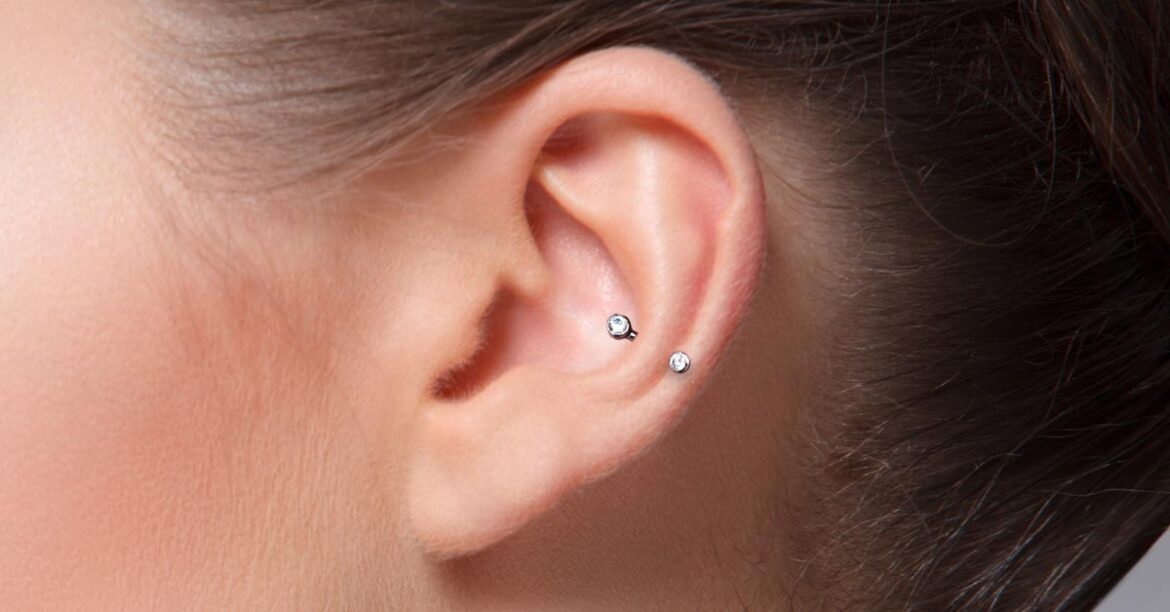What Is Snug Piercing?
Snug piercing is a perforation of the earlobe that is placed in the innermost part of the ear.
It is also sometimes called an anti-tragus piercing.
The snug piercing is done through the cartilage, which makes it a bit more challenging than a traditional earlobe piercing.
One of the benefits of a snug piercing is that it can be quite discreet.
It’s not as large as other types of piercings and is unlikely to be seen from most angles. For those who are interested in body
modification but don’t want something that’s too visible, a snug piercing is a great option.
The origins of snug piercing are difficult to trace, but it is believed that the style originated in South America.
It is thought that the piercing was originally done as a form of body modification and/or ritualistic act.
The piercings were often done in groups, with multiple piercings being made in one ear.
Ear Piercing Interactive Chart
How Painful Is Snug Piercing?
The pain level can vary depending on the individual’s pain tolerance.
The cartilage is slightly thicker than the skin, so there may be some discomfort when the needle first goes through.
However, most people report that the pain is manageable and relatively short-lived.
What Are The Risks and Complications?
As with any piercing, there are some risks and complications associated with snug piercings.
These include:
Infection: The risk of infection is always present with any piercing.
Be sure to clean the piercing regularly and follow the aftercare instructions provided by your piercer.
Rejection: The body may reject the piercing, which means that the jewelry will be pushed out of the hole.
This is more likely to happen with cartilage piercings than with earlobe piercings.
Scarring: Scarring is possible with any piercing, but it is more likely to occur with cartilage piercings.
Nerve damage: There is a risk of nerve damage with any piercing, but it is especially common with cartilage piercings.
This can result in pain, numbness, or tingling sensations in the ear.
Jewelry problems: The jewelry used in a snug piercing can often cause problems.
The small size of the ring can make it difficult to clean and can also cause the piercing to close up.
In some cases, the jewelry may also irritate the skin.
If you are considering a snug piercing, be sure to discuss all of the risks and complications with your piercer.
They will be able to advise you on whether or not this type of piercing is right for you.
What Is The Procedure Of Snug Piercing?
The procedure for snug piercing is relatively simple.
First, the area to be pierced will be cleaned and sterilized.
Next, a needle will be inserted through the cartilage at the desired location.
Once the needle is through, the jewelry will be inserted.
The piercer will then check to make sure that the jewelry is in place and that the piercing is healing properly.
What is The Healing Time & Aftercare Of Snug Piercing?
The aftercare is similar to the aftercare for other types of piercings.
Be sure to clean the piercing regularly with a mild soap and warm water.
You may also need to use an antibiotic ointment or cream to help prevent infection. Avoid touching the piercing or using
any harsh chemicals, such as hair dyes.
It is important to note that snug piercings can take longer to heal than other types of piercings.
The average healing time is 4-6 weeks, but it can take up to 12 weeks for the piercing to fully heal.
Be patient and follow the aftercare instructions closely to ensure a successful healing process.
What Type Of Jewelry Can Be Worn For Snug Piercing?
The most common type of jewelry worn in a snug piercing is a small ring.
There are a number of different earrings that can be worn in a snug piercing.
This includes traditional studs, hoops, and barbells.
The type of earring that is best for you will depend on your personal style and the look that you are going for.
If you are looking for a more traditional look, then studs are a good option.
They are small and discreet, and they can be worn in any type of piercing.
Hoops are also a popular choice for snug piercings.
They come in a variety of different sizes and styles, so you can find the perfect set for your needs.
If you are looking for something a bit more unique, then barbells are a great option. Barbells are available in a variety of
different metals, including steel, titanium, and gold. They can also be decorated with a variety of different gemstones or
other charms.
It is important to choose jewelry that is made from a safe and non-irritating material, such as stainless steel or titanium.
Be sure to check with your piercer to find out what type of jewelry is right for you.
How Much Does It Cost?
The cost can vary depending on the location,
the piercer, and the type of jewelry used.
Prices typically range from $30 to $50.
To Sum Up…
The snug piercing is a unique and stylish way to decorate your ears.
The procedure is relatively simple and most people report that the pain is manageable.
Healing times can vary, but it is important to be patient and follow the aftercare instructions closely.
For other types of piercings PRESS HERE

